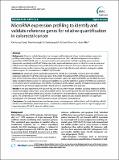| dc.contributor.author | Chang, Kah Hoong | en |
| dc.contributor.author | Mestdagh, Pieter | en |
| dc.contributor.author | Vandesompele, Jo | en |
| dc.contributor.author | Kerin, Michael J. | en |
| dc.contributor.author | Miller, Nicola | en |
| dc.date.accessioned | 2010-08-20T10:25:28Z | en |
| dc.date.available | 2010-08-20T10:25:28Z | en |
| dc.date.issued | 2010 | en |
| dc.identifier.citation | Chang,K. H., Mestdagh, P., Vandesompele, P., Kerin M. J., Miller, N. (2010), MicroRNA expression profiling to identify and validate reference genes for relative quantification in colorectal cancer BMC Cancer, 10:173 | en |
| dc.identifier.uri | http://hdl.handle.net/10379/1273 | en |
| dc.description.abstract | Background
Advances in high-throughput technologies and bioinformatics have transformed gene expression profiling methodologies. The results of microarray experiments are often validated using reverse transcription quantitative PCR (RT-qPCR), which is the most sensitive and reproducible method to quantify gene expression. Appropriate normalisation of RT-qPCR data using stably expressed reference genes is critical to ensure accurate and reliable results. Mi(cro)RNA expression profiles have been shown to be more accurate in disease classification than mRNA expression profiles. However, few reports detailed a robust identification and validation strategy for suitable reference genes for normalisation in miRNA RT-qPCR studies.Methods
We adopt and report a systematic approach to identify the most stable reference genes for miRNA expression studies by RT-qPCR in colorectal cancer (CRC). High-throughput miRNA profiling was performed on ten pairs of CRC and normal tissues. By using the mean expression value of all expressed miRNAs, we identified the most stable candidate reference genes for subsequent validation. As such the stability of a panel of miRNAs was examined on 35 tumour and 39 normal tissues. The effects of normalisers on the relative quantity of established oncogenic (miR-21 and miR-31) and tumour suppressor (miR-143 and miR-145) target miRNAs were assessed.Results
In the array experiment, miR-26a, miR-345, miR-425 and miR-454 were identified as having expression profiles closest to the global mean. From a panel of six miRNAs (let-7a, miR-16, miR-26a, miR-345, miR-425 and miR-454) and two small nucleolar RNA genes (RNU48 and Z30), miR-16 and miR-345 were identified as the most stably expressed reference genes. The combined use of miR-16 and miR-345 to normalise expression data enabled detection of a significant dysregulation of all four target miRNAs between tumour and normal colorectal tissue.Conclusions
Our study demonstrates that the top six most stably expressed miRNAs (let-7a, miR-16, miR-26a, miR-345, miR-425 and miR-454) described herein should be validated as suitable reference genes in both high-throughput and lower throughput RT-qPCR colorectal miRNA studies. | en |
| dc.format | application/pdf | en |
| dc.language.iso | en | en |
| dc.publisher | Biomed Central | en |
| dc.rights | Attribution-NonCommercial-NoDerivs 3.0 Ireland | |
| dc.rights.uri | https://creativecommons.org/licenses/by-nc-nd/3.0/ie/ | |
| dc.subject | Surgery | en |
| dc.title | MicroRNA expression profiling to identify and validate reference genes for relative quantification in colorectal cancer | en |
| dc.type | Article | en |
| dc.local.publishedsource | http://www.ncbi.nlm.nih.gov/pmc/articles/PMC2873395 | en |
| dc.description.peer-reviewed | peer-reviewed | en |
| nui.item.downloads | 401 | |


